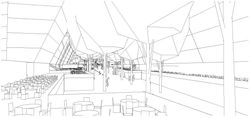 Sports District |  Neighbourhood Scale |  Arts District |  Winter Classics |  Food District |  Retail District |
|---|
5D
Toronto Yard, 2014
Allen Road (formerly Allen Expressway), Toronto; Urban Design
Exhausted but not defeated, Toronto returns home from work to embrace the evening ahead. Against the sunset, light breeze, and choirs of songbirds, city people dined on the patio. But no one ate too full, because that 3-on-3 hockey match-up is still on with the neighbours. And on the sidelines, someone pulled out a book, another pulled out a paintbrush, and grandpa, he just pulled back and slept. These are a few ways Toronto enjoys the yard.
By 1976, a segment of the unfinished Spadina Expressway, later renamed Allen Road, has decimated a midtown community. Spanning between Highway 401 and the uprising Eglinton Avenue, Allen Road has sliced through the residential area like zebra mussels in our Great Lakes. It has disturbed local lifestyles and diminished urban characters. Specifically, it has limited crossing, restricted pedestrian thoroughfare, and orphaned open spaces. The Allen is the antithesis of public space: it’s loud, hasty, pungent, and ugly. So, vehicular traffic will be reduced, and t hen removed from the Allen Road. The existing traffic load will be re-integrated into the city network; it is senseless to continue clogging an unfinished expressway that doesn’t lead downtown.
The Yard project will amend the divide with a new type of open space that blurs public use and private ownerships; it’ll be called the Public Yard, and is mediated by the Private Yard. Under the model of public private partnerships, private realty will catalyzes these new public spaces; and the scars of Allen Road will be incrementally stitched with new amenities, identities, and business opportunities.
Each of these developments will be a district, characterized by the unique services indigenous of Toronto’s culture: arts, food, market, sports, water, and retail. The scale of the intensification will be contextually appropriate but not timid; it’ll be grand, but intimate. By building a people-first public yard, corporations and citizens will collectively re-purpose the Allen Road with new life and purpose.
Cities were built for people and not cars. - Ontario Premier William Davis at the 1971 Provincial Legislature, announcing the stop of Spadina Expressway construction.
[Click Images Below]

Retail District: Shopping

Water District: Living

Water District: Living

Sports District: Playing

Sports District: Playing

Sports District: Playing

Market District: Groceries

Food District: Dining

Arts District: Learning and Working

Arts District: Learning and Working

The Walking Experience: All Districts

The Walking Experience: Retail and Water Districts
Principles of Design
-
Sensitive Intensification ie. mid-rise development in mid-rise neighbourhoods
-
Stitching the torn Urban Fabric ie. New nodes, landmarks, paths, edges and districts
-
Neighbourhood Scale ie. Victorian House in the Annex, Row Houses in Cabbagetown
Poster Presentation
[Click Images Below]

Poster 1

Poster 2

Poster 3

Poster 4

Poster 5

Poster 6

Schematic Presentation